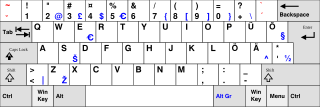
Estonian is a Finnic language of the Uralic family. Estonian is the official language of Estonia. It is written in the Latin script and is the first language of the majority of the country's population; it is also an official language of the European Union. Estonian is spoken natively by about 1.1 million people: 922,000 people in Estonia and 160,000 elsewhere.

Finno-Ugric is a traditional linguistic grouping of all languages in the Uralic language family except for the Samoyedic languages. Its once commonly accepted status as a subfamily of Uralic is based on criteria formulated in the 19th century and is criticized by some contemporary linguists such as Tapani Salminen and Ante Aikio. The three most spoken Uralic languages, Hungarian, Finnish, and Estonian, are all included in Finno-Ugric.

The Uralic languages, sometimes called the Uralian languages, are spoken predominantly in Europe and North Asia. The Uralic languages with the most native speakers are Hungarian, Finnish, and Estonian. Other languages with speakers above 100,000 are Erzya, Moksha, Mari, Udmurt and Komi spoken in the European parts of the Russian Federation. Still smaller minority languages are Sámi languages of the northern Fennoscandia; other members of the Finnic languages, ranging from Livonian in northern Latvia to Karelian in northwesternmost Russia; and the Samoyedic languages, Mansi and Khanty spoken in Western Siberia.

Votic or Votian, is a Finnic language spoken by the Votes of Ingria, belonging to the Finnic branch of the Uralic languages. Votic is spoken only in Krakolye and Luzhitsy, two villages in Kingiseppsky District in Leningrad Oblast, Russia. In the 2020–2021 Russian census, 21 people claimed to speak Votic natively, which is an increase from 4 in 2010. Arvo Survo also estimated that around 100 people have knowledge of the language to some degree.

Votians, also referred to as Votes, Vots and Vods are a Finnic ethnic group native to historical Ingria, the part of modern-day northwestern Russia that is roughly southwest of Saint Petersburg and east of the Estonian border-town of Narva. The Finnic Votic language spoken by Votians is close to extinction. The language is still spoken in three villages of historical Votia and by an unknown number of speakers in the countryside. The villages are Jõgõperä (Krakolye), Liivcülä (Peski), and Luuditsa (Luzhitsy). In the Russian 2020 census, 99 people identified as Votian.

Ingrian, also called Izhorian, is a Finnic language spoken by the Izhorians of Ingria. It has approximately 70 native speakers left, most of whom are elderly.

Võro is the language of South Estonia, belonging to the Finnic branch of the Uralic language family. Governmentally, it has been considered a dialect of the Estonian language along with all varieties of South Estonian. However, many linguists consider South Estonian to be an independent Finnic language. It has its own literary standard and efforts have been undertaken to seek official recognition as an indigenous regional language of Estonia. Võro has roughly 75,000 speakers (Võros), mostly in southeastern Estonia, in the eight parishes of the historical Võru County: Karula, Harglõ, Urvastõ, Rõugõ, Kanepi, Põlva, Räpinä and Vahtsõliina. These parishes are currently centred in Võru and Põlva counties, with parts extending into Valga and Tartu counties. Speakers can also be found in the cities of Tallinn and Tartu and the rest of Estonia.
The exessive case is a grammatical case that denotes a transition away from a state. It is a rare case found in certain dialects of Baltic-Finnic languages. It completes the series of "to/in/from a state" series consisting of the translative case, the essive case and the exessive case.

The Finnic or Baltic Finnic languages constitute a branch of the Uralic language family spoken around the Baltic Sea by the Baltic Finnic peoples. There are around 7 million speakers, who live mainly in Finland and Estonia.
Estonian vocabulary, i.e., the vocabulary of the Estonian language, was influenced by many other language groups.

The official language of Estonia is Estonian, a Uralic language of the Finnic branch, which is related to Finnish. It is unrelated to the bordering Russian and Latvian languages, both of which are Indo-European.

South Estonian is either a Finnic language or an Estonian dialect, spoken in south-eastern Estonia, encompassing the Tartu, Mulgi, Võro and Seto varieties. There is no academic consensus on its status as a dialect or language. Diachronically speaking, North and South Estonian are separate branches of the Finnic languages.

Finnish is a Finnic language of the Uralic language family, spoken by the majority of the population in Finland and by ethnic Finns outside of Finland. Finnish is one of the two official languages of Finland, alongside Swedish. In Sweden, both Finnish and Meänkieli are official minority languages. Kven, which like Meänkieli is mutually intelligible with Finnish, is spoken in the Norwegian counties of Troms and Finnmark by a minority of Finnish descent.
Proto-Finnic or Proto-Baltic-Finnic is the common ancestor of the Finnic languages, which include the national languages Finnish and Estonian. Proto-Finnic is not attested in any texts, but has been reconstructed by linguists. Proto-Finnic is itself descended ultimately from Proto-Uralic.

The Kukkuzi dialect or Kukkusi dialect (Куровицы) is a dialect of Votic spoken in Kukkuzi. The Kukkuzi dialect has been heavily influenced by Ingrian.

Tiit-Rein Viitso was an Estonian linguist.

Siberian Finnish or Korlaka is the form of Finnish spoken in Siberia by the Siberian Finns. Siberian Finnish is an umbrella name, this name refers to at least two languages/dialects.
The Ingrian language is a highly endangered language spoken in Ingria, Russia. Ingrian is a Uralic language of the Finnic branch, along with, among others, Finnish and Estonian. Ingrian is an agglutinative language and exhibits both vowel harmony and consonant gradation.

Siberian Ingrian Finnish is a Lower Luga Ingrian Finnish – Lower Luga Ingrian (Izhorian) mixed language. The ancestors of the speakers of this language migrated from the Rosona River area to Siberia in 1803–1804. Most native speakers of this language live in Ryzhkovo or nearby, as well as in Omsk and Tallinn (Estonia).














